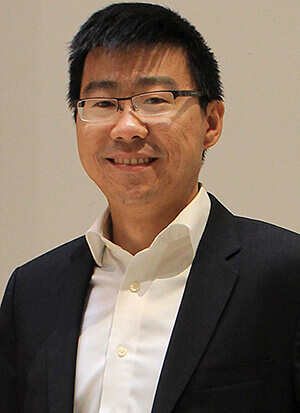February 5, 2018
Research team publish work on solar cell film phase transitions
 Assistant professor Letian Dou (Photo/Jennifer Merzdorf)
Assistant professor Letian Dou (Photo/Jennifer Merzdorf)
Download image
WEST LAFAYETTE, Ind. — A Purdue University professor and a multi-institution team of researchers recently published a paper on solar cells in Nature Materials.
Letian Dou, an assistant professor in the Davidson School of Chemical Engineering, worked on the article, “Thermochromic halide perovskite solar cells,” which focuses on the team’s research of the structural-phase transition behaviors in mixed halide perovskite thin films.
The phase transitions result in solar cell films with two switchable characteristic states, each having distinct visible transparencies and photovoltaic device efficiencies. These films are expected to be useful in the development of smart photovoltaic windows.
“This study, for the first time, demonstrates that inorganic halide perovskites semiconductors are suitable for this type of device because of their ‘soft’ and ‘dynamic’ lattice, which allow reversible phase transition without degrading the electronic properties,” Dou said. “This is fundamentally different from traditional semiconductors such as Si or GaAs. This discovery will now open up new applications for semi-transparent solar cells. We can now tune their color.”
In addition to Dou, the team includes researchers from the University of California-Berkeley’s departments of Chemistry and Materials Science and Engineering; the U.S. Department of Energy’s Lawrence Berkeley National Laboratory, Berkeley, Calif.; Shanghai University of Electric Power, Shanghai, China; Berzelii Center EXCELENT on Porous Materials, Stockholm University, Stockholm, Sweden; Lawrence Livermore National Laboratory, Livermore, Calif; and Kavli Energy NanoScience Institute, Berkeley, Calif.
Findings are detailed in the Jan. 17 in Nature Communications: https://www.nature.com/articles/s41563-017-0006-0
In this work, Dou contributed to the design of the device architecture and the phase transition dynamics study. A profile on Dou and his research into low-cost, high-output hybrid solar cells is at https://youtu.be/HoK5bySnO6E
The solar cells undergo reversible transitions, which are thermally driven at 150-200 degrees Celsius and moisture mediated. Researchers found the cells transition between a transparent, non-perovskite phase with 81.7 percent visible transparency and a low power output to a deeply colored perovskite phase with a reduced transparency of 35.4 percent and a high power output. The solar cell features high thermal stability and fully reversible color and performance, both of which are key requirements for successfully integrating the cells into diverse applications.
 An illustration displays the day to night changes and potential power output in solar cell film transitions. (Illustration/Jia Lin)
Download image
An illustration displays the day to night changes and potential power output in solar cell film transitions. (Illustration/Jia Lin)
Download image
Smart photovoltaic windows represent a promising green technology, with practical integrated applications in buildings, automobiles, information displays and many other technologies. Current semi-transparent photocells are effective in providing light, shade, and power output, but these photocells do not have any color-changing characteristics. Smart photovoltaic windows, as researched by the team, provide all of the same aspects as semi-transparent photocells, and also allow switchable transparencies that harvest and manage incoming solar energy.
Dou notes that the all-inorganic phase transition system developed in his team’s research is more robust toward degradation.
“The films can be switched over 100 times without obvious degradation, making the inorganic perovskites more suitable for commercial applications,” he said. “The research team is now exploring new materials toward lower-phase transition temperatures and faster transition kinetics.”
Writer: Jennifer Merzdorf, 765-496-8779, jmerzdo@purdue.edu
Source: Letian Dou, 765-494-4194, dou10@purdue.edu
Note to Journalists: Additional media is available at https://goo.gl/RxSaMU. For additional video, contact Erin Easterling, digital producer in Purdue's College of Engineering, easterling@purdue.edu, 765-496-3388.
ABSTRACT
Thermochromic halide perovskite solar cells
Jia Lin123, Minliang Lai1, Letian Dou124, Christopher S. Kley1, Hong Chen1, Fei Peng5, Junliang Sun5, Dylan Lu12, Steven A. Hawks126, Chenlu Xie1, Fan Cui1, A. Paul Alivisatos1278, David T. Limmer127 , Peidong Yang1278
1 Department of Chemistry, University of California, Berkeley, California
2 Materials Sciences Division, Lawrence Berkeley National Laboratory, Berkeley, California
3 Department of Physics, Shanghai University of Electric Power, Shanghai, China
4 Davidson School of Chemical Engineering, Purdue University, West Lafayette, Indiana
5 Berzelii Center EXSELENT on Porous Materials, Department of Materials and Environmental Chemistry, Stockholm University, Stockholm, Sweden
6 Lawrence Livermore National Laboratory, Livermore, California
7 Kavli Energy NanoScience Institute, Berkeley, California
8 Department of Materials Science and Engineering, University of California, Berkeley, California
Smart photovoltaic windows represent a promising green technology featuring tunable transparency and electrical power generation under external stimuli to control the light transmission and manage the solar energy. Here, we demonstrate a thermochromic solar cell for smart photovoltaic window applications utilizing the structural phase transitions in inorganic halide perovskite caesium lead iodide/bromide. The solar cells undergo thermally-driven, moisture-mediated reversible transitions between a transparent non-perovskite phase (81.7 percent visible transparency) with low power output and a deeply coloured perovskite phase (35.4 percent visible transparency) with high power output. The inorganic perovskites exhibit tunable colours and transparencies, a peak device efficiency above 7 percent, and a phase transition temperature as low as 105 degrees Celsius. We demonstrate excellent device stability over repeated phase transition cycles without colour fade or performance degradation. The photovoltaic windows showing both photoactivity and thermochromic features represent key stepping-stones for integration with buildings, automobiles, information displays, and potentially many other technologies.

